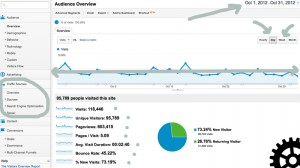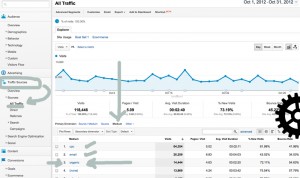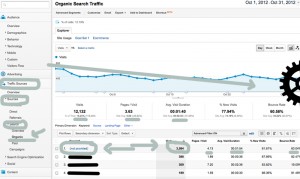Search Engine Optimization and Google Analytics
Getting Started with Google Analytics

Google Analytics baby
The question of the week have all been Google Analytics related. Like “where did you get that?”
Since I get to evaluate businesses that use Google Analytics, I thought I’d walk you through part of my process.
I start where everyone does: What are the current customers doing on the site? That’s it. No judgement. I try to keep the assumptions at bay and look at it with an unbiased eye. Here’s one with October as the sample month:
At this point, it’s all pretty high level. Kind of like opening the car hood. “Is anything obviously wrong? Like a disconnected cable?”
Nothing jumps out here. I put some dots where my eye is drawn. What’s the time period? (I use the day and week and month to spot trendlines) What is the trend? Take note of the basic stats: visitors, unique visitors, pageviews, duration etc.
Then it’s off the area I circled: Where is this traffic coming from?
Let’s drill into that.
I clicked on the Traffic Sources menu and then All Traffic. To protect the innocent, I sorted by Medium. If your Google Analytics is set up correctly, this is a great way to group traffic.
If the sort was by the default Source, it would show a bunch of details. I don’t want that. Not now. I’m still trying to feel my way around the traffic.
What is there to see here? CPC check. Email check. Aha! Organic traffic.
Organic traffic is generally my #1 interest because it’s a good indicator of what the search engines think of the content on the site. Some caveats here: New Sites have no data. So we guess a lot. Sites where Google Analytics was set, then forgotten – lots of data, but it’s hard to sort through. Sites with Google Analytics that have been organized well – lots to learn. This is an example of the latter.
Let’s drill into the Organic Traffic.
A little more going on here. I have gone further into the Traffic Sources menu. Under All Traffic is Search and under Search is Organic.
I see a slight decline in organic traffic. That’s a scritch on my notepad. I see that organic is 10% of the total traffic in October. Not sure what that means. A quick aside here – you may notice that Page Views and Time on Site are lower than the sitewide trend. This happens with Organic because the Long Tail gives you all sorts of oddball traffic. Just sayin’.
Back to the analysis. . .the traffic is sorted by visits. The #1 visitor is (not provided). What the wha?
When you start to get down, things like this jump out and I get distracted. This one started showing up in my businesses around December 2011.
Where do I go to find out what this means? Just like you, I head to the InterNets!
I know you probably already know this, but those Google Auto-Suggestions are a killer marketing tool. In this case, the machine is telling me what the most common searches are. And this time I will succumb and pick Google Analytics Not Provided Organic because that’s who I am.
Where does that take me?
I probably do the same things you do here. Peek at the Synopsis. If it’s the one that looks chock full of the information I want, I click! (so pay attention to your Meta Descriptions and such)
Another side note. . .interesting how there aren’t any ads on searches like this, right? Studies are telling us that in the B2B market up to 60% of buyers are doing their own “research” before contacting a sales person. I’m guessing most early information gathering searches look like this one. . . The mind wonders if there’s an opportunity to tailor ads and content here? Bam.
Back to business here. The synopsis tell me that the culprit is Google + users. Makes sense. As a Google + user I’d like to keep some anonymity.
As a marketer, I’d like to know it all.
Ok – so what do we do with the 25% of organic traffic that is (not provided)?
Work it backwards. Ultimately, we have to assume the Google + users are rough mirrors of the general public and move on.
As my old mentor used to say, “sub-optimal”. Then he moved on.
That’s what comes next for me too. Just keep digging. Looking for insights that I can translate into tests.
The data-driven approach.
Good stuff.
About the Author: Greg Chambers is Chambers Pivot Industries. Get more business development ideas from Greg on Twitter.





